
DV300/DV301B 30" Multimedia Information Display
11. Technical Specifications
LCD PANEL
• Type TFT LCD
• Screen size 29.5 inch
• Pixel Pitch 0.5025 x 0.1675 mm x RGB
• LCD Panel type 1280 x 768 pixels
R.G.B. vertical stripe
Hard coating surface, anti-glare polarizer
• Effective viewing area (H) 643.2 x (V) 385.92mm
• Display Colours 8 bits interface (16.7M colours)
PC SCANNING
• Vertical refresh rate 56Hz-61Hz
• Horizontal frequency 31kHz-63kHz
PC VIDEO
• Video dot rate < 80 MHz
• Input impedance
- Video 75 ohm
- Sync 2.2K ohm
• Input signal levels 0.7 Vpp
• Sync input signal Separate sync
• Sync polarities Positive and negative
• Input Frequency WXGA Hsync 48 kHz, Vsync 60 Hz (N.I.)
SVGA Hsync 38 kHz, Vsync 60 Hz (N.I.)
VGA Hsync 31 kHz, Vsync 60 Hz (N.I.)
• Video interface D-sub, S-Video, TV-RF, SCART (Europe) or composite and
components video (others)
AUDIO
• Input level for PC/SVHS/SCART 500 mV nominal
• Loudspeaker 5W Stereo Audio (2.5W/channel RMS x2, 200Hz~10kHz,
4 ohm, 10% THD)
58
Q: What are the advantages of TFT LCD compared with CRT?
A: In a CRT monitor, a gun shoots electrons and general light by colliding polarized electrons on
fluorescent glass. Therefore, CRT monitors basically operate with an analogue RGB signal. A TFT LCD
monitor is a device that displays an input image by operating a liquid crystal panel. The TFT has a
fundamentally different structure than a CRT: Each cell has an active matrix structure and independent
active elements. A TFT LCD has two glass panels and the space between them is filled in with liquid
crystal. When each cell is connected with electrodes and impressed with voltage, the molecular
structure of the liquid crystal is altered and controls the amount of inlet lighting to display images. A TFT
LCD has several advantages over a CRT, since it can be very thin and no flickering occurs because it
does not use the scanning method.
Q: Why is a vertical frequency of 60Hz optimal for an LCD monitor?
A: Unlike a CRT monitor, the TFT LCD panel has a fixed resolution. For example, an XGA monitor has
1024x3 (R, G, B) x 768 pixels and a higher resolution may not be available without additional software
processing. The panel is designed to optimise the display for a 65MHz dot clock, one of the standards
for XGA displays. Since the vertical/horizontal frequency for this dot clock is 60Hz/48kHz, the optimum
frequency for this monitor is 60Hz.
Q: What kind of wide-angle technology is available? How does it work?
A: The TFT LCD panel is an element that controls/displays the inlet of a backlight using the dual refraction
of a liquid crystal. Using the property that the projection of inlet light refracts toward the major axis of
the liquid element, it controls the direction of inlet light and displays it. Since the refraction ratio of inlet
light on liquid crystal varies with the inlet angle of the light, the viewing angle of a TFT is much narrower
than that of a CRT. Usually, the viewing angle refers to the point where the contrast ratio is 10. Many
ways to widen the viewing angle are currently being developed and the most common approach is to
use a wide viewing angle film, which widens the viewing angle by varying the refraction ratio. IPS (In
Plane Switching) or MVA (Multi Vertical Aligned) is also used to give a wider viewing angle.
Q: Why is there no flicker on an LCD Monitor?
A: Technically speaking, LCDs do flicker, but the cause of the phenomenon is different from that of CRT
monitor — and it has no impact of the ease of viewing. Flickering in an LCD monitor relates to usually
undetectable luminance caused by the difference between positive and negative voltage. On the other
hand, CRT flickering that can irritate the human eye occurs when the on/off action of the fluorescent
object becomes visible. Since the reaction speed of liquid crystal in an LCD panel is much slower, this
troublesome form of flickering is not present in an LCD display.
Q: Why is an LCD monitor virtually free of Electro Magnetic Interference?
A: Unlike a CRT, an LCD monitor does not have key parts that generate Electro Magnetic Interference,
especially magnetic fields. Also, since an LCD display utilizes relatively low power, its power supply is
extremely quiet.
57


















